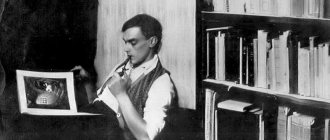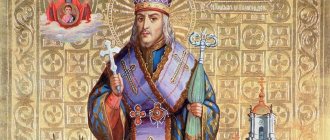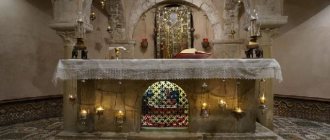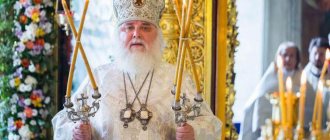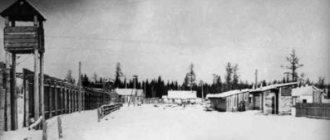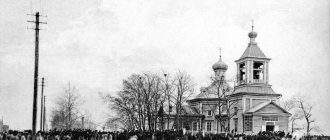Life of St. Arseny Konevsky
Arseny Konevsky took monastic vows in the Novgorod Lisitsky Monastery in the name of the Nativity of the Virgin Mary during the years of the abbess there of Euthymius, later the saint, Archbishop of Novgorod. Having lived in the monastery for 11 years, Arseny Konevsky, together with an Athonite monk who had visited Novgorod, went to Athos, where he spent 3 years. At first, Arseny Konevsky worked in “woodworking, baking bread and other monastic services,” after the abbot learned about Arseny Konevsky’s craft, he ordered the monk to forge vessels in silence. The saint visited many Athonite monasteries, for which he made vessels free of charge. The monks, seeing him “working like a bodiless slave or like a bought slave, were surprised at his patience, but also loved him even more.” Leaving Athos, Arseny Konevsky received from Abbot John the “ Charter of the Holy Mountain ” and the miraculous icon of the Most Holy Theotokos, on the back of which was written the Image of the Savior Not Made by Hands.
In 1393, Arseny Konevsky returned to Novgorod and soon, with the blessing of Archbishop John II, set sail along the Volkhov River to Lake Velikoye Nevo (Ladoga) in search of a place to create a monastery. It is known that Arseny visited Valaam, but, seeing that the monastery was crowded, he left it. Having reached Konevets Island, Arseny decided to sail further, but the wind drove the boat in which he and his students were located back. Arseny Konevsky landed on the island in a place that later became known as Filippova Lakhta ; in the 19th century, a cross was erected here and a monastery was built. Then Arseny moved to the bay, which, after a visit to the monastery by the Novgorod Archbishop Euthymius (Vyazhitsky), probably in 1444, began to be called Vladychnaya Lakhta. Here, around 1393, a monastery arose; in 1398, a church was built in the monastery in honor of the Nativity of the Virgin Mary. the monk Lavrenty came to him , sent by the Valaam abbot Silas to call Arseny to Valaam, but he did not agree, because he fell in love with the silent Konevets. Initially, the Konevsky Monastery, apparently, was not strictly communal. One night, a certain perspicacious elder of the monastery heard a conversation between two demons. One of them said that all Novgorodians praise the life of the Konevsky abbot. Another confirmed that the monastic rule is “without blemish,” but in the life of Arseny Konevsky, the consolation for demons is that he keeps treats in his cell for the monastery’s benefactors. The next morning, the elder told everything to Arseny, and he ordered the cellarer to arrange a common meal in the monastery and not to keep anything in the cells. Arseny drove out demons from the Horse-Stone located on the island, to which the pagans made sacrifices. After Arseny, together with the monastery priest, sprinkled the stone with holy water, the fishermen saw a flock of ravens flying north and roaring like oxen. After the exorcism of demons, according to monastic tradition, Arseny blessed the construction of a chapel on top of the Horse-Stone; the chapel was restored at the end of the 19th century. The monastery stood at its original location for 25 years, then due to flooding its location was changed.
Arseny Konevsky visited Athos for the second time. During his absence, there was a severe famine in the monastery, and the monks wanted to disperse. The monk of the monastery, Joachim , prayed in the forest to the Most Holy Theotokos so that she would protect the monastery. The Most Pure Virgin Herself appeared to him, saying in consolation that the Monk Arseny would soon return and bring everything he needed. The next day Arseny arrived, delivering “many things needed” on 2 ships. The place where Joachim prayed began to be called the Holy Mountain, later a cross was erected there, and in the 19th century a monastery was built, where on the day of remembrance of the saint a religious procession was held from the monastery.
During Arseny’s lifetime, John became abbot of the Konevskaya monastery. Dying, Arseny Konevsky bequeathed to the brethren of the monastery to keep the Charter of the Holy Mountain, “to keep the meal equal.” Arseny reposed in 1447. He was buried on the porch of the church in honor of the Nativity of the Virgin Mary, and subsequently a chapel was built over the place of his burial in the name of St. Onuphrius the Great .
Empty
- Seal
Blessed Arseny came from Veliky Novgorod, but it is unknown who his parents were and at what time he was born. His heart, inflamed with the love of Christ, prompted him to leave the world to seek the silent life. First, he retired to the monastery of the Nativity of the Virgin Mary, neighboring Veliky Novgorod, on Fox Mountain.
The saint lived there for eleven years, having completed the monastic test, cut his hair and became a perfect monk. All the brethren looked at him as a model of monastic life given to them from above.
NOVOGORODETS ON ATHOS
The desire to visit the Holy Mount Athos had long lived in the soul of the Monk Arseny, and he took advantage of the coming to Novgorod of a certain Athonite monk. Falling with tears at the feet of the abbot, Arseny begged to be released to Mount Athos. For a long time the abbot did not agree to his request, feeling what a deprivation it would cause for the monastery, but finally he could not help but yield to the tearful prayer of the zealous monk.
Arseny joyfully went on his way with a fatherly blessing, and safely reached the Holy Mountain, where he was lovingly received by Abbot John. The abbot ordered the stranger to strive in common labors with the brethren. Therefore, Arseny went through all the monastic services in order, starting with woodworking and baking bread, and performed every service with extreme humility and obedience, considering himself to be the worst of the brethren.
The abbot, having learned the art of the Russian newcomer forging copper vessels, occupied him preferably with this handicraft, and in deep silence he forged vessels for the needs of the monastery, devoted the whole day to this, and spent the night in prayer, barely allowing himself little rest, for he was strong and courageous . He worked without compensation not only for his monastery, but also for other Svyatogorsk monasteries; for from everywhere they brought him copper for forging vessels, as soon as they heard about his art. It is not known in which actual monastery the Monk Arseny asceticised; however, it must probably be assumed that in Rossikon, for it was the common refuge of all Russian newcomers.
Fearing that the multitude of those who came to him would not burden the brethren of his monastery, he accepted the blessing from his abbot to go around all the monasteries of the Holy Mountain in order to work for the benefit of each of them, not for the sake of gold and silver, but for spiritual salvation, and remained in such a feat for three of the year. Then the desire came to him to return to his native land in order to establish a monastery there for the glory of the Mother of God, in Whom he had warm faith. Arseny began to ask the abbot for leave to his homeland, and he, filled with the spirit of clairvoyance, prophetically told him that the Lord would build through him a monastery in the northern country, which would be saved by his prayers from many demonic charms and superstitions.
The abbot fatherly blessed him with the double icon of the Lady with the Eternal Child on the one hand, and the Holy Image of Spasov on the other, giving him the Charter of the Holy Mountain. Letting him go, he prayed over him like this: “God our father, look from the throne of Thy glory on Thy servant Arseny, may the grace of Thy Holy Spirit always rest on him and Thy blessing be with him.”
NORTH HOUSE
In 1393, Blessed Arseny returned to Veliky Novgorod, carrying with him the miraculous icon of the Mother of God from the Holy Mountain, later called Konevskaya. Here he appeared before Archbishop John II, to whom he told everything that had happened to him on Athos, and asked for his blessing to create a monastery in the north in the name of the Nativity of the Virgin Mary. The bishop released him in peace, and Arseny with the icon of the Mother of God sailed into Lake Ladoga.
Having been in the Valaam monastery, he decided to go into silence to more secluded places and, by the Providence of God, reached the deserted island of Konevsky. From here the monk decided to go further, but the wind drove the boat in which he and his disciples were sailing back. Here, around 1393/94, a monastery arose, and in 1398 a temple was erected in the monastery in honor of the Nativity of the Virgin Mary. The monk expelled demons from the Horse-stone located on the island (hence the name Konevsky), to which the pagans made sacrifices. After Saint Arseny, together with the monastery priest, sprinkled the stone with holy water, the fishermen saw a flock of ravens flying north and roaring like oxen.
After the exorcism of demons, according to monastic tradition, the monk blessed the construction of a chapel on the top of the Horse-Stone. After the establishment of the monastery and the increase of the brethren, the Monk Arseny again went to Holy Mount Athos, this was under the Novgorod Archbishop Simeon (1416-1421). Then there was a great scarcity in his monastery, so that the brethren, overcome by hunger, wanted to disperse. But one of the elders, named Joachim, adorned with piety and gray hair, ascended the mountain closest to the monastery, where the monk first labored, and prayed to the Heavenly nourisher Mother of God to send them their daily bread.
Rev. Arseny Konevsky.
After a long prayer, the elder dozed off, and through a subtle sleep the Mother of God appeared to him in Heavenly glory. “Don’t grieve, elder,” She said in a quiet voice, “tell the brethren not to leave this place, for soon Arseny himself will come to you with an abundance of everything you need for the monastery.” The next day, Arseny actually sailed on two large ships and brought with him a lot of supplies.
In 1421, an extraordinary flood of Lake Ladoga, which washed away some of the buildings of the poor monastery, forced the Monk Arseny to move the monastery to a new place on the same island, where little by little he built a stone church with wooden cells and a fence. Archbishop Euthymius, who entered the department from the Lisichy Monastery, greatly assisted the monk in establishing a new monastery. Konevets then became famous for many in Novgorod. Pious Novgorodians began to visit the monastery secluded on the island and delivered their benefits to it.
In his cares and labors for the good of the monastery and in the exploits of monasticism, the Monk Arseny reached a very old age. Even during the life of the monk, John became hegumen of the Konevsk monastery. Before his repose, Saint Arseny bequeathed to the brethren of the monastery to keep the Rule of the Holy Mountain, “to keep the meal equal.” Entrusting his monastery to the Mother of God, he promised in spirit not to part with the brethren and at the very moment of his exodus, supported by his disciples, he partook of the Divine Mysteries and peacefully departed to the Lord on June 12 (25), 1447, on the day when the Holy Church celebrates the memory of Saints Onuphrius and Peter of Athos, following whose example he labored. The Charter of the Holy Mountain, introduced by the Monk Arseny in the Konevsky monastery, was adopted in 1865 by the Verkolsky Artemiev Monastery in the Pinezhsky district of the Arkhangelsk province.
MIRACLES AND REVERENCE OF THE REVEREND
The Monk Arseny is revered as the patron saint of sailors. So, once he saved the elder Moses and the fishermen from death. The fishermen caught in the storm prayed to the Lord; The saint who appeared overshadowed them with his mantle, and the boat safely landed on the shore. Evidence of the veneration of St. Arseny has been preserved since the 16th century. Since the 18th century, the troparion, kontakion and prayer to St. Arseny of Konevsky have been known, and in 1819, by decision of the Holy Synod, the name of St. Arseny was included in all monthly books.
Pimen, Archimandrite of Konevsky and Valaam († December 22, 1910), the author of the description of the monastery, reports that the relics of St. Arseny were found in the 16th century, but during the Livonian War (1558-1583) they were again buried near the western wall of the Church of the Nativity. In 1577, after the capture of the Konevsky monastery by the Swedes, the brethren, together with abbot Leonty, moved to the Derevyanitsky monastery, taking with them the miraculous Konevsky image of the Blessed Virgin Mary. The Swedes destroyed the Nativity Cathedral of the Konevsky Monastery.
On June 12, 1809, a new stone Cathedral of the Nativity of the Virgin Mary was consecrated, built on the site of one destroyed by the Swedes, and on August 21, 1849, St. Ignatius Brianchaninov consecrated a new church in the monastery in the name of St. Arseny Konevsky. In May 1991, the Konevsky Monastery was transferred to the Russian Orthodox Church, and in November of the same year, the relics of St. Arseny were found under the floor of the lower Sretensky Church of the Nativity Cathedral.
Published based on the book: “History of the Russian St. Panteleimon Monastery on Athos from ancient times to 1735.” Series “Russian Athos of the 19th-20th centuries”, volume 5. – Athos: St. Panteleimon Monastery, 2015 .
See also
To give your life for others: several facts from the life of Schemamonk Glikeriy (Nikitin). Day of Remembrance
Every person has at least one opportunity in life to prove the sincerity of their faith in God, to show their love for Him and people, but we often do this...
Hieroschdeacon Benedict. Memorial Day - December 24
Hieroschdeacon Benedict, a Greek by birth, lived on Holy Mount Athos for more than 70 years. He was a very educated and highly spiritual monk. The Patriarch of Constantinople sent three times...
Assistant to the tireless elder: Hieroschemamonk Vladimir (Kolesnikov). Memorial Day - December 23
Hieroschemamonk Vladimir (in the world Vasily Vasilyevich Kolesnikov) was born on July 27, 1851 in the village of Chudovo, Novgorod province. His father Vasily and mother Evdokia died...
Secretary of the Athonite Elder Macarius, Hieroschemamonk Mina (Budanov)
On December 3, 1888, Hieroschemamonk Mina (Budanov), the long-term secretary of the Athonite elder Macarius (Sushkin), abbot of the Russian on ...
The work of God must be done without delay: Hieroschemamonk Arseny (Minin). Memorial Day - 30
No one ever heard an idle word come from his lips. Father Arseny was often silent and thoughtful, those present with him felt that in his heart...
Confessor and cathedral elder: Hieroschemamonk Theodoret (Konstantinov). Memorial Day - November 19
Hieroschemamonk Theodorit (in the world Fedor Semenovich Konstantinov) was born in 1856 into a peasant family in the village of Pogozhem, Timsky district, Kursk province. His mother's name was...
The oldest copy of the miraculous Kazan Icon of the Mother of God from the Panteleimon Monastery on Mount Athos
On November 4, in the Athos St. Panteleimon Monastery, they prayerfully honored the memory of the Kazan miraculous icon of the Mother of God, reports a correspondent of the Russian Athos portal.
Strict ascetic and hospitable governor: Hieroschemamonk Gerasim (Popov). Memorial Day - October 26
Hieroschemamonk Gerasim (in the world Gleb Petrovich Popov) was born on June 24, 1859 into a peasant family in the village of Rozhkovech, Oryol province. Subsequently, his family moved...
Hieromartyr Hilarion (Gromov). Memorial Day - October 11
“Dear father! Our life is hard and bitter,” the future new martyr wrote to the abbot of the Panteleimon Monastery. “There are no words to express to you the sadness that has visited us.” We, …
How to learn humility: Schemamonk Onisifor (Ishchenko). Memorial Day - October 11
Schemamonk Onisifor (in the world Onisim Karpovich Ishchenko) was born in 1872 into a peasant family in the village of Rubanskoye, Bratslav district, Kamenets-Podolsk province. Since childhood he was silent...
- Tags:
- Athos
- Holy Mountain
- Panteleimon Monastery
- Konevsky Monastery
- Arseny Konevsky
Miracles and veneration of St. Arseny Konevsky
Evidence of the veneration of Arseny Konevsky has been preserved since the 16th century: in 1551, a cover with an embroidered image of the saint was placed in the Konevsky monastery by the boyar children M.K. Brovtsyn and G.I. Shchetinin . The compiler of the “Tale of the Valaam Monastery” (late 50s - 60s of the 16th century) mentions “the great leader of the monastery... Saint Arseny.” The first dated posthumous miracle performed by the saint dates back to 1573: a resident of the Korel land, Afanasy Belyay , was captured and worked in the house of a certain Swede. Athanasius used to pray in front of the icon of the Savior, and one day the Lord appeared to him in a dream, commanding him to take the icon and go to Konevets. While sailing on the sea, when everyone on the ship was sleeping, Athanasius was awakened by Arseny Konevsky, the saint said: “Get up and look at the sea, behold, the serpent is wheezing.” The people awakened by Afanasy saw the Swedish ship and managed to escape.
The memory of Arseny Konevsky is included in the month of Simon (Azaryin) on September 8, his death is noted on June 12. In the “Description of Russian Saints,” the repose of the saint is dated September 9.
The relics of Arseny Konevsky were discovered in the 16th century, but during the Livonian War (1558-1583) they were again buried near the western wall of the Church of the Nativity, on the left side of the doors, where the relics remained until the monastery was rebuilt in 1718. In 1577, after the capture of the Konevsky monastery by the Swedes, the brethren, together with abbot Leonty, moved to the Derevyanitsky monastery , taking with them the miraculous Konevsky image of the Blessed Virgin Mary, the shrine cover of the saint from 1551, a wooden ladle set in silver, which, according to legend, belonged to the monk . In 1595, after peace was concluded with Sweden, the monks returned to the monastery. However, following the signing of the Russian-Swedish treaty in 1610, according to which Russia ceded the city of Korel and the entire Korel land to the Swedes, the Konevo monks were again forced to leave for the Derevyanitsky monastery. The Swedes destroyed the Nativity Cathedral of the Konevsky Monastery, the bricks were used to build a fortress in Korel.
In 1760, the Konevskaya monastery, which had previously been attached to the Derevyanitsky monastery, was recognized as independent; the Konevsky builder Ignatius returned the shrines that had previously been taken to the Derevyanitsky monastery. On June 12, 1809, the new stone Cathedral of the Nativity of the Virgin Mary was consecrated, built on the site of what was destroyed by the Swedes; in 1817, in the lower Sretensky Church of the Cathedral, over the relics of Arseny Konevsky, which were kept under wraps, a new mahogany shrine was built, decorated with silver embossing, on the shrine was Full size image of the monk. In 1843 it was replaced by a new silver shrine made by F.A. Verkhovtsev .
Konevsky Nativity of the Mother of God Monastery
On August 21, 1849, the monastery church in the name of Arseny Konevsky, built in the northeastern corner tower of the monastery, was consecrated. Today the Konevsky Monastery is a functioning monastery of the Russian Orthodox Church.
Monument to St. Arseny Konevsky on the territory of the Konevsky Nativity of the Mother of God Monastery
St. Arseny, Konevsky miracle worker
Akathist to our Venerable and God-Bearing Father Arsenius, the Konevsky Wonderworker
Kontakion 1
Chosen wonderworker and wonderful servant of Christ, Reverend Our Father Arseny, good and faithful servant of the Lord, you have illuminated the east and north with your labors and exploits. Glorifying the Lord who glorified you, let us sing praises to you as a zealous servant of the Mother of God; You, as if you have the grace to pray for us, remember us, who sing to you with love: Rejoice, Reverend Arseny, Konevsky, miracle worker. Ikos 1
Desiring to live like an angel, you clothed yourself in an angelic image and a heavenly man appeared on earth, and the same angelic voices befittingly praise you, Reverend Father Arseny; but even if we are burdened with sins, we still dare with love to sing human praises to you: Rejoice, Novagrad the Great, God-planted tree; Rejoice, you who brought the fruits of virtues to the world. Rejoice, inexhaustible treasure of love; Rejoice, fragrant receptacle of the Divine world. Rejoice, inexhaustible source of patience; Rejoice, inexhaustible reservoir of goodness. Rejoice, immeasurable abyss of mercy; Rejoice, most famous rule of faith. Rejoice, most eminent form of meekness; Rejoice, wonderful teacher of abstinence. Rejoice, bearer of the burdens of sin flowing to You; Rejoice, zealous executor of the Law of Christ. Rejoice, Reverend Arseny, Konevsky miracle worker. Kontakion 2
Seeing this fickle life and all sorts of vanity in the world, Reverend Father Arseny, from his youth you tried to adorn yourself with virtues and prepare for the Highest Zion, the city of the Living God, where now the Angels and all the saints eat: Alleluia. Ikos 2
The incomprehensible mind, hidden by the saints in Heavenly Jerusalem, desiring to comprehend, having abandoned the earthly, you moved into the monastery within the boundaries of Novagrad on the mountain, Reverend Father Arseny, and there, having lived like an angel, you were the path to the salvation of all who cry out to you: Rejoice, poor in spirit in Kingdom of Heaven to the driver; Rejoice, you who mourn for God the Comforter. Rejoice, preparer of the meek for a wondrous inheritance; Rejoice, true satiator of those who hunger for righteousness. Rejoice, you who thirst for sweet drink for eternal life; Rejoice, invisible partner of the merciful. Rejoice, humble teacher of the pure in heart; Rejoice, loving teacher of peacemakers. Rejoice, faithful companion exiled for the sake of truth; Rejoice, fellow sufferer who endure reproach for Christ's sake. Rejoice, dwelling with all the saints; Rejoice, in the Kingdom of the Heavenly Father, enlightened like the sun. Rejoice, Reverend Arseny, Konevsky miracle worker. Kontakion 3
The power of the Most High strives, Reverend Father Arseny, for great deeds, and your soul desires the Mighty God - the Living, like one who thirsts for trees for springs of water; For this reason, you came from the land of your fatherland to Mount Athos, and you reached the inheritance of the Mother of God, singing to God: Alleluia. Ikos 3
Having a God-seeing mind and desiring to conceal your virtues, so that the Heavenly Father, seeing in secret, will reward you openly, for this sake you have reached the Svyatogorsk monastery, Reverend Father Arseny, and there you have received a blessing from Abbot John to participate in common work with the brethren, but we, Seeing your good will, we cry to you: Rejoice, you who have acquired heavenly gifts by your virtues; Rejoice, thou who imitated the holy forefathers in good life. Rejoice, for you have acquired Abraham’s faith in God; Rejoice, for you had obedience to Isaac. Rejoice, for thou hast been worthy of Jacob's vision of God; Rejoice, for you kissed Joseph’s chastity. Rejoice, for you have gained patience with Job; Rejoice, for you have gained the compassion of Moses. Rejoice, for you heard Samuel’s call to God; Rejoice, for you have accepted David’s meekness. Rejoice, for you carried Elijah’s zeal for God in your heart; Rejoice, for you were Daniel's abode of the Holy Spirit. Rejoice, Reverend Arseny, Konevsky miracle worker. Kontakion 4
Blessed John was filled with a storm of sadness when you, Reverend Father Arseny, flew three times to the northern country and wanted to return; Having foreseen Divine Providence for you, bless you on your journey, praying with the words: “Lord God of our fathers, from the Throne of Your glory look upon your servant Arseny, may the grace of Your Most Holy Spirit rest on him always, may You sing: Alleluia.” Ikos 4
Hearing that the monks of Athos heard that blessed Arseny was leaving Mount Athos, they began to feel great sorrow; Having seen the future with perspicacious eyes, Abbot John presented the image of the Mother of God with the Eternal Child and said: Rejoice, for through you God will erect a monastery in the country to the north; Rejoice, for there the tempter will be put to shame. Rejoice, for you will receive a reward for your zeal for the Mother of God; Rejoice, for you have been glorified in heaven by Her Son. Rejoice, for you will be an angel to talk to; Rejoice, for a good mentor has appeared as a man. Rejoice, new luminary of the cold north; Rejoice, who through the love of Christ has dispersed the darkness of vanity. Rejoice, for through you many people will understand the sweetness of spiritual life; Rejoice, for those on earth will be partakers of the face of the Angels. Rejoice, star, showing the way to Christ; Rejoice, mental sun - holy icons of Our Lady of the Chariot. Rejoice, Reverend Arseny, Konevsky miracle worker. Kontakion 5
Having become more like a godly star, you flowed from the east to the north to Veliky Novgrad, Reverend Father Arseny, and there you received a blessing for the construction of a monastery in the name of the Most Pure Virgin from the saint, who kissed the icon of the Mother of God that you brought and cried out with tears: Alleluia. Ikos 5
Seeing you filled with many virtues, the saint of Novagrad with blessing grants you something necessary for the construction of a new monastery, and you received this reverently, Rev. Father Arseny, on a boat along the Volkhov River and the great Ladoga Lake to the Valaam monastery; We, with our mental eyes, seeing the way you are doing, cry out for your praise as follows: Rejoice, Father, of the same name as the fathers of courage; Rejoice, having surrendered everything to the will of God. Rejoice, you who have completely accepted the good yoke; Rejoice, you who bore the burden of Christ more easily. Rejoice, invisible helper of those who labor in the Lord; Rejoice, teacher of those burdened with sins to repentance. Rejoice, petrified insensibility of the repellor; Rejoice, the giver of good hope in despair. Rejoice, you who have received the meekness of Christ; Rejoice, having taught His humility to those who come to you. Rejoice, protection and affirmation of the monastics; Rejoice, hope of all faithful people. Rejoice, Reverend Arseny, Konevsky miracle worker. Kontakion 6
The preacher of your virtuous life and miracles from the icon of the Mother of God, upon your coming to the island of Konevsky, the fisherman Philip, who kindly received you, appeared, and with you he belted God: Alleluia. Ikos 6
You shone with the light of your virtues on the island of Konevstem, where, like a desert-loving turtledove, having settled in and lived a solitary life, in your place of residence you first erected the honorable Cross; Having taken away, Abba Silas the ambassador of the monk Lawrence, let him call you back to the monastery of Valaam, he came and saw your godly life, Reverend Father Arseny, saying to you: Rejoice, ascetic guided by God; Rejoice, true servant of the Virgin Mary. Rejoice, wondrous preacher of God's truth; Rejoice, unhypocritical accuser of lies. Rejoice, planter of right faith; Rejoice, eradicator of superstition. Rejoice, teacher of chastity; Rejoice, obedience to the teacher. Rejoice, destroyer of hatred; Rejoice, Divine peace to the omnipotent. Rejoice, you who strive for the Lord, the strengthener; Rejoice, corrector of those who have fallen into sin. Rejoice, Reverend Arseny, Konevsky miracle worker. Kontakion 7
I want, Reverend Father Arseny, to create a monastery on the island of Konevstem, first of all you erected a small temple in honor of the Mother of God, in which those who want to walk the path of virtuous life and worship God: Alleluia. Ikos 7
You created a new miracle when, with all those who had gathered to you, you took the icon of the Mother of God and came to the so-called Horse-Stone, and with diligent prayer you drove away the evil spirits living there; We, knowing this, in praise of you, Reverend Father Arseny, cry out as follows: Rejoice, having put to shame the devil by fasting and prayer; Rejoice, having protected yourself from the snares of the enemy with the cross. Rejoice, you who drove away evil spirits from the Stone Horse; Rejoice, deliverer from the deceit of the surrounding people from the deceit of the surrounding people. Rejoice, salt of the earth, born from the water of baptism; Rejoice, you who refresh those who flow in with the power of the Divine. Rejoice, city of Christ, standing on the top of the mountain; Rejoice, adorned with heavenly light. Rejoice, lamp, shining in this world with virtues; Rejoice, burning with love for God and your neighbors. Rejoice, a quiet refuge for those overwhelmed by heresies; Rejoice, unshakable pillar of Orthodoxy. Rejoice, Reverend Arseny, Konevsky miracle worker. Kontakion 8
You were a great lover of strangers, like the ancient Abraham, O Reverend Father Arseny; The good devil hates the desire of this virtue to create an obstacle; When you realized his wickedness, then you commanded to establish a common institution for those who came, singing to God, the nourisher of all: Alleluia. Ikos 8
You truly entrusted all of yourself and all the new brethren gathered in the monastery to the care of the Mother of God, Reverend Father Arseny, when, after flying some packs to Mount Athos to the feet of the feat, you wanted to return to the holy fathers; Your God-gathered child, seeing you off, calls to you: Rejoice, good teacher, entrusting us to the care of the Mother of God; Rejoice, you who taught never to fall into despair. Rejoice, thou who hast bequeathed above all things to seek the Kingdom of Heaven; Rejoice, for to those who seek this, earthly things will also be added, the verb. Rejoice, thou who has subdued thy flesh to the spirit; Rejoice, you who have revealed the fruits of the spirit to the world. Rejoice, servant of God, crucified with Christ; Rejoice, vessel of Divine grace. Rejoice, for through you God is glorified; Rejoice, for through you the demons are put to shame. Rejoice, great consolation for the sad; Rejoice, unexpected joy for those who mourn. Rejoice, Reverend Arseny, Konevsky miracle worker. Kontakion 9
All the foreigners in your monastery, Reverend Father Arseny, gave themselves up to great sorrow, and lingered on Athos: for hunger is heavy and poverty has befallen them, and they want to be separated from each other; And to those who thought this, the Mother of God appeared in a dream to your beloved disciple Elder Joachim, grieving greatly over this, and saying to him: “Do not grieve, elder, but the shepherds of the brethren, let them abide in the monastery, for My servant Arseny will soon come with a multitude of those in need.” to you, singing to God: Alleluia.” Ikos 9
Sweet words cannot explain your virtues and miracles, Reverend Father Arseny; Having heard such a desire to come to you from Novagrad, for the sake of spiritual benefit, Saint Euthymius of Christ, who came and loved you as much as the high priest gave you his old hood, saying: Rejoice, earthly angel and heavenly man; Rejoice, fellow citizen of the saints and close to God. Rejoice, you who have put aside the old man with his passions; Rejoice, you have put on Christ. Rejoice, wondrous warrior, who has received all the weapons of God; Rejoice, you who created a monastery in the name of the Mother of God. Rejoice, you who resisted the wiles of the enemy; Rejoice, pure dwelling place of the Holy Spirit. Rejoice, repository of virtues; Rejoice, Lordship of God's commandments. Rejoice, radiance of the Lord’s justifications; Rejoice, lover of solitary life. Rejoice, Reverend Arseny, Konevsky miracle worker. Kontakion 10
To save your watery monastery from danger, you moved it to an elevated place, O Reverend Father Arseny, and the charter, betrayed by the holy fathers, leaving, instead of yourself, you chose Elder John as abbot, singing to God: Alleluia. Ikos 10
The wall and refuge, the icon of the Lady of Svyatogorsk, having left those living in your monastery and having partaken of the Holy Mysteries, you bequeathed a dying covenant, saying: “If you remain in the law of the Lord, then this monastery will not become poor and the Mother of God will be its patroness,” the same spirit according to these words You betrayed your Lord to the Lord, Reverend Father Arseny, and those around your bed cried out: Rejoice, for you have strengthened yourself with Heavenly Bread before your departure into eternal life; Rejoice, for you drank the cup of the Lord before your death. Rejoice, luminary of Orthodoxy, rising in the north of heaven; Rejoice, having reached the Heavenly Light, Christ God. Rejoice, for you remain alive by faith; Rejoice, for after your departure your spirit does not leave us. Rejoice, our new representative before God; Rejoice, warmest prayer book for our souls. Rejoice, holy one, numbered among the saints; Rejoice, O righteous one, having reached heavenly rest. Rejoice, having received a worthy reward for your labors; Rejoice, good servant, who has entered into the joy of his Lord. Rejoice, Reverend Arseny, Konevsky miracle worker. Kontakion 11
All singing is not sufficient to glorify your miracles, Reverend Father Arseny, after your repose he appeared everywhere in multitudes, saving from drowning and healing from illnesses those who came to you and cried out to God: Alleluia. Ikos 11
Having appeared all luminous, you saved the old man Moses and the fishermen from drowning, you appeared to a blind man in Novegrad, you sent him to your monastery for healing, you strengthened the weakened monk Lawrence, you corrected John from a stupor of mind, Reverend Father Arseny, they were delivered from troubles and illnesses , you cry out in gratitude: Rejoice, thou who hast continued the sorrowful life of God unto death in this world; Rejoice, conqueror of worldly vanity in Christ. Rejoice, after death you made your faith known by your works; Rejoice, for being human, you perform great miracles. Rejoice, heir of the promises of Christ; Rejoice, partaker of His glory. Rejoice, salvation from drowning; Rejoice, sight for the blind. Rejoice, healing of the weakened; Rejoice, correction of those who have lost their minds. Rejoice, teacher of those who have gone astray; Rejoice, you who are overcome with help. Rejoice, Reverend Arseny, Konevsky miracle worker. Kontakion 12
The grace to perform wondrous miracles was given to you from God, Rev. Father Arseny; For you delivered Athanasius and his friend from the captivity of Sweisk, and you appeared in a dream to the grieving monk in the Valaam monastery, sent him to your monastery, and asked for prayers for him, you said to him: “If you abstain from wine and talking a lot, then I will make a prayer for you,” crying out to God: Alleluia. Ikos 12
Singing your miracles, we praise you, Reverend Father Arseny, and honor your holy memory, crying out in praise: Rejoice, King of kings - servant of Christ the Lord; Rejoice, heavenly powers to your roommate. Rejoice, confirmation of Orthodoxy; Rejoice, shame on heresies. Rejoice, healer of the sick; Rejoice, deliverer from captivity. Rejoice, you who call the listener in truth; Rejoice, comforter of the sorrowful at heart. Rejoice, glorification of the faithful; Rejoice, reproof of the unfaithful. Rejoice, wonderful intercessor of those who weep for sins before God; Rejoice, loving father of the repentant. Rejoice, Reverend Arseny, Konevsky miracle worker. Kontakion 13
O reverend and most glorious Father Arseny, consolation of the sorrowing and healing of the infirm, accept now this small offering and pray to the Lord for all of us to be delivered from future torment, and let us cry out to Him with you: Alleluia. (This kontakion is read three times, then ikos 1 and kontakion 1) Prayer to St. Arseny, Konevsky Wonderworker
O Reverend Father Arseny, viewer of unspeakable glory in the Kingdom of Heaven. Do not leave your monastery, where you have accomplished your labors and deeds for Christ, but keep it in peace and silence, so that it may remain unshakable from the tricks of enemies, visible and invisible. Strengthen your children in good deeds; you have gathered them, O wise man, into your monastery, so that they may know their calling, so that they may be worthy of the Mother of God’s care for them. Visit from the heights of heaven all who faithfully flow to you through your life-giving prayer. Rule those who float on the sea. Calm the turmoil of the sea of this life. Tame church discord. Ask the Lord for peace from the Lord for all of us. Heal the sick with your saving intercession. In sorrows, be a comforter and a good mentor. Be everything to everyone, just as you were in your earthly life. Make a prayer to God, for you have been given the grace to pray for us. We know, we know truly, how much the prayer of a righteous person, hastened by the intercession of the Mother of God, can do. Even if we are unworthy, entrust us also to Her omnipotent protection and intercession, so that we may be worthy to receive bliss in the Kingdom of Her Son, Christ our God, together with you and all the saints forever and ever. Amen.
Troparion and Kontakion to St. Arseny Konevsky
Troparion, tone 8.
ABOUT! you, Father Arseny, know the speed of salvation. Let us accept the cross, for you followed Christ. But whoever does and learns to despise the flesh passes away, but to practice things more immortal for the soul. In the same way the angels rejoice, O venerable spirit.
Kontakion, tone 2.
Having divinely armed yourself with spiritual purity, and unceasing prayer, as if you had firmly handed over a copy, you prosecuted the demonic host Arseny, Our Father, pray unceasingly for all of us.
Rev. Arseny Konevsky. Icons
The earliest surviving image of the Monk Arseny Konevsky is the embroidered cover of 1551 on the coffin of the saint, donated by Brovtsyn and Shchetinin. Arseny Konevsky is presented in full growth, upright, in monastic vestments, with his head uncovered and a wide bushy beard, with his right hand pointing to a scroll in his left; At the top there is an inscription: “Reverend Arseny the Elder of the Konevsky Monastery.”
Rev. Arseny Konevsky. Sewn cover. 1551 Museum of Orthodox Art Kuopio, Finland
The iconography of the ancient tombstone probably dates back to the half-length rectal images of Arseny Konevsky, which became widespread in the 18th-19th centuries: local icons of the first quarter of the 19th century from the iconostases of the churches of the Konevetsky Monastery and Pyadnik icons. Another type of depiction of the Venerable Arseny Konevsky developed at the end of the 18th - early 19th centuries, simultaneously with the appearance of a new edition of the life of Arseny Konevsky: the monk is presented against the backdrop of a newly built stone monastery in prayer to the Konevskaya Icon of the Most Holy Theotokos, full-length, in monastic robes, with his right hand pointing to the monastery, in his left hand he holds an unfolded scroll, usually with the text: “Brotherhood, let us love God and each other, as we are commanded.”
Rev. Arseny Konevsky. First quarter of the 19th century. St. Petersburg, State Historical Museum
In iconographic originals, the appearance of Arseny Konevsky was usually likened to the appearance of the monks Sergius of Radonezh, Joseph of Volotsky, Ephraim the Syrian .
Rev. Arseny Konevsky. Modern icon
